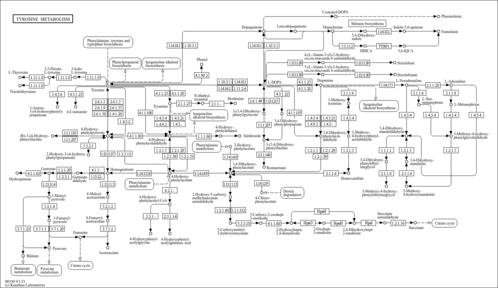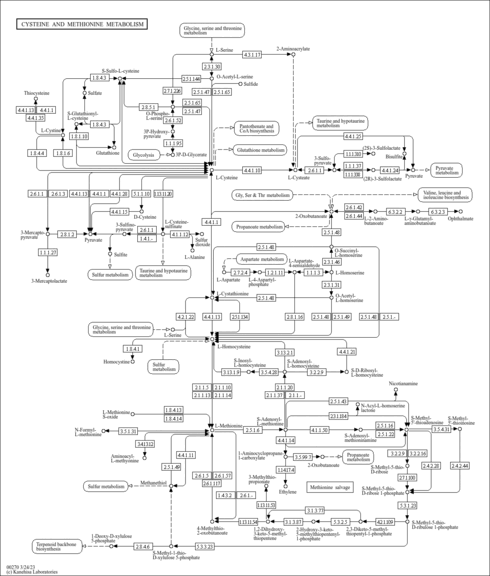| 5-aminolevulinate synthase, erythroid-specific, mitochondrial | ALAS2 | Xp11.21 | P22557 | details |
| 85/88 kDa calcium-independent phospholipase A2 | PLA2G6 | 22q13.1 | O60733 | details |
| Tartrate-resistant acid phosphatase type 5 | ACP5 | 19p13.2 | P13686 | details |
| Ribonucleoside-diphosphate reductase large subunit | RRM1 | 11p15.5 | P23921 | details |
| Ribonucleoside-diphosphate reductase subunit M2 | RRM2 | 2p25-p24 | P31350 | details |
| NADH-ubiquinone oxidoreductase chain 1 | MT-ND1 | | P03886 | details |
| NADH dehydrogenase [ubiquinone] 1 beta subcomplex subunit 1 | NDUFB1 | 14q32.12 | O75438 | details |
| NADH dehydrogenase [ubiquinone] iron-sulfur protein 2, mitochondrial | NDUFS2 | 1q23 | O75306 | details |
| Succinate dehydrogenase cytochrome b560 subunit, mitochondrial | SDHC | 1q23.3 | Q99643 | details |
| Peroxisomal N(1)-acetyl-spermine/spermidine oxidase | PAOX | 10q26.3 | Q6QHF9 | details |
| NADH dehydrogenase [ubiquinone] 1 alpha subcomplex subunit 12 | NDUFA12 | 12q22 | Q9UI09 | details |
| NADH dehydrogenase [ubiquinone] 1 alpha subcomplex subunit 1 | NDUFA1 | | O15239 | details |
| NADH dehydrogenase [ubiquinone] 1 alpha subcomplex subunit 4-like 2 | NDUFA4L2 | 12q13.3 | Q9NRX3 | details |
| NADH dehydrogenase [ubiquinone] 1 alpha subcomplex subunit 3 | NDUFA3 | 19q13.42 | O95167 | details |
| NADH dehydrogenase [ubiquinone] 1 alpha subcomplex subunit 8 | NDUFA8 | 9q33.2 | P51970 | details |
| NADH dehydrogenase [ubiquinone] 1 alpha subcomplex subunit 4 | NDUFA4 | 7p21.3 | O00483 | details |
| NADH-ubiquinone oxidoreductase chain 4L | MT-ND4L | | P03901 | details |
| NADH dehydrogenase [ubiquinone] 1 alpha subcomplex subunit 11 | NDUFA11 | 19p13.3 | Q86Y39 | details |
| Lathosterol oxidase | SC5DL | 11q23.3 | O75845 | details |
| NADH dehydrogenase [ubiquinone] iron-sulfur protein 4, mitochondrial | NDUFS4 | 5q11.1 | O43181 | details |
| NADH dehydrogenase [ubiquinone] iron-sulfur protein 3, mitochondrial | NDUFS3 | 11p11.11 | O75489 | details |
| NADH dehydrogenase [ubiquinone] iron-sulfur protein 5 | NDUFS5 | 1p34.2-p33 | O43920 | details |
| NADH dehydrogenase [ubiquinone] flavoprotein 2, mitochondrial | NDUFV2 | 18p11.22 | P19404 | details |
| NADH dehydrogenase [ubiquinone] 1 alpha subcomplex subunit 10, mitochondrial | NDUFA10 | 2q37.3 | O95299 | details |
| NADH dehydrogenase [ubiquinone] 1 alpha subcomplex subunit 6 | NDUFA6 | 22q13.2 | P56556 | details |
| NADH dehydrogenase [ubiquinone] 1 beta subcomplex subunit 4 | NDUFB4 | 3q13.33 | O95168 | details |
| Succinate dehydrogenase [ubiquinone] flavoprotein subunit, mitochondrial | SDHA | 5p15 | P31040 | details |
| Heme oxygenase 2 | HMOX2 | 16p13.3 | P30519 | details |
| NADH dehydrogenase [ubiquinone] iron-sulfur protein 8, mitochondrial | NDUFS8 | 11q13 | O00217 | details |
| NADH-ubiquinone oxidoreductase chain 2 | MT-ND2 | | P03891 | details |
| NADH dehydrogenase [ubiquinone] 1 alpha subcomplex subunit 7 | NDUFA7 | 19p13.2 | O95182 | details |
| NADH dehydrogenase [ubiquinone] 1 alpha subcomplex subunit 2 | NDUFA2 | 5q31 | O43678 | details |
| NADH-ubiquinone oxidoreductase 75 kDa subunit, mitochondrial | NDUFS1 | 2q33-q34 | P28331 | details |
| NADH dehydrogenase [ubiquinone] 1 beta subcomplex subunit 5, mitochondrial | NDUFB5 | 3q26.33 | O43674 | details |
| NADH dehydrogenase [ubiquinone] 1 subunit C2 | NDUFC2 | 11q14.1 | O95298 | details |
| NADH dehydrogenase [ubiquinone] 1 beta subcomplex subunit 3 | NDUFB3 | 2q31.3 | O43676 | details |
| NADH dehydrogenase [ubiquinone] 1 beta subcomplex subunit 7 | NDUFB7 | 19p13.12 | P17568 | details |
| Acyl carrier protein, mitochondrial | NDUFAB1 | 16p12.2 | O14561 | details |
| NADH dehydrogenase [ubiquinone] 1 alpha subcomplex subunit 5 | NDUFA5 | 7q32 | Q16718 | details |
| Electron transfer flavoprotein-ubiquinone oxidoreductase, mitochondrial | ETFDH | 4q32-q35 | Q16134 | details |
| NADH dehydrogenase [ubiquinone] 1 alpha subcomplex subunit 9, mitochondrial | NDUFA9 | 12p13.3 | Q16795 | details |
| NADH-ubiquinone oxidoreductase chain 4 | MT-ND4 | | P03905 | details |
| Succinate dehydrogenase [ubiquinone] cytochrome b small subunit, mitochondrial | SDHD | 11q23 | O14521 | details |
| NADH dehydrogenase [ubiquinone] iron-sulfur protein 7, mitochondrial | NDUFS7 | 19p13.3 | O75251 | details |
| Xanthine dehydrogenase/oxidase | XDH | 2p23.1 | P47989 | details |
| NADH dehydrogenase [ubiquinone] flavoprotein 1, mitochondrial | NDUFV1 | 11q13 | P49821 | details |
| NADH dehydrogenase [ubiquinone] 1 beta subcomplex subunit 9 | NDUFB9 | 8q13.3 | Q9Y6M9 | details |
| NADH-ubiquinone oxidoreductase chain 6 | MT-ND6 | | P03923 | details |
| NADH dehydrogenase [ubiquinone] 1 alpha subcomplex subunit 13 | NDUFA13 | 19p13.2 | Q9P0J0 | details |
| NADH dehydrogenase [ubiquinone] iron-sulfur protein 6, mitochondrial | NDUFS6 | 5p15.33 | O75380 | details |
| Succinate dehydrogenase [ubiquinone] iron-sulfur subunit, mitochondrial | SDHB | 1p36.1-p35 | P21912 | details |
| Heme oxygenase 1 | HMOX1 | 22q13.1 | P09601 | details |
| Uroporphyrinogen decarboxylase | UROD | 1p34 | P06132 | details |
| Methylsterol monooxygenase 1 | MSMO1 | 4q32-q34 | Q15800 | details |
| Phytanoyl-CoA dioxygenase, peroxisomal | PHYH | 10p13 | O14832 | details |
| Tyrosine 3-monooxygenase | TH | 11p15.5 | P07101 | details |
| Thyroid peroxidase | TPO | 2p25 | P07202 | details |
| Lactoperoxidase | LPO | 17q23.1 | P22079 | details |
| Phenylalanine-4-hydroxylase | PAH | 12q22-q24.2 | P00439 | details |
| Myeloperoxidase | MPO | 17q23.1 | P05164 | details |
| Eosinophil peroxidase | EPX | 17q23.1 | P11678 | details |
| Prolyl 4-hydroxylase subunit alpha-2 | P4HA2 | 5q31 | O15460 | details |
| Prolyl 4-hydroxylase subunit alpha-1 | P4HA1 | 10q21.3-q23.1 | P13674 | details |
| Acyl-CoA desaturase | SCD | 10q24.31 | O00767 | details |
| Gamma-butyrobetaine dioxygenase | BBOX1 | 11p14.2 | O75936 | details |
| Procollagen-lysine,2-oxoglutarate 5-dioxygenase 1 | PLOD1 | 1p36.22 | Q02809 | details |
| Procollagen-lysine,2-oxoglutarate 5-dioxygenase 2 | PLOD2 | 3q24 | O00469 | details |
| Procollagen-lysine,2-oxoglutarate 5-dioxygenase 3 | PLOD3 | 7q22 | O60568 | details |
| Tryptophan 5-hydroxylase 1 | TPH1 | 11p15.3-p14 | P17752 | details |
| Tryptophan 5-hydroxylase 2 | TPH2 | 12q21.1 | Q8IWU9 | details |
| Flavin reductase (NADPH) | BLVRB | 19q13.1-q13.2 | P30043 | details |
| Aconitate hydratase, mitochondrial | ACO2 | 22q13.2 | Q99798 | details |
| Cytoplasmic aconitate hydratase | ACO1 | 9p21.1 | P21399 | details |
| Dihydropyrimidine dehydrogenase [NADP(+)] | DPYD | 1p22 | Q12882 | details |
| Inositol oxygenase | MIOX | 22q13.3 | Q9UGB7 | details |
| 4-hydroxyphenylpyruvate dioxygenase | HPD | 12q24-qter | P32754 | details |
| Homogentisate 1,2-dioxygenase | HGD | 3q13.33 | Q93099 | details |
| Cysteine dioxygenase type 1 | CDO1 | 5q23.2 | Q16878 | details |
| Arachidonate 5-lipoxygenase | ALOX5 | 10q11.2 | P09917 | details |
| Arachidonate 15-lipoxygenase B | ALOX15B | 17p13.1 | O15296 | details |
| Arachidonate 12-lipoxygenase, 12S-type | ALOX12 | 17p13.1 | P18054 | details |
| Prostaglandin G/H synthase 2 | PTGS2 | 1q25.2-q25.3 | P35354 | details |
| Prostaglandin G/H synthase 1 | PTGS1 | 9q32-q33.3 | P23219 | details |
| Arachidonate 15-lipoxygenase | ALOX15 | 17p13.3 | P16050 | details |
| Cytochrome b-c1 complex subunit Rieske, mitochondrial | UQCRFS1 | 19q12 | P47985 | details |
| Protoporphyrinogen oxidase | PPOX | 1q22 | P50336 | details |
| Aspartyl/asparaginyl beta-hydroxylase | ASPH | 8q12.1 | Q12797 | details |
| Pantothenate kinase 2, mitochondrial | PANK2 | 20p13 | Q9BZ23 | details |
| Thiosulfate sulfurtransferase | TST | 22q13.1 | Q16762 | details |
| Ferrochelatase, mitochondrial | FECH | 18q21.3 | P22830 | details |
| Galactose-1-phosphate uridylyltransferase | GALT | 9p13 | P07902 | details |
| NADH dehydrogenase [ubiquinone] 1 beta subcomplex subunit 11, mitochondrial | NDUFB11 | | Q9NX14 | details |
| 3-hydroxyanthranilate 3,4-dioxygenase | HAAO | 2p21 | P46952 | details |
| Beta,beta-carotene 15,15'-monooxygenase | BCMO1 | 16q23.2 | Q9HAY6 | details |
| Cytochrome c oxidase subunit 1 | MT-CO1 | | P00395 | details |
| Serine/threonine-protein phosphatase PP1-beta catalytic subunit | PPP1CB | 2p23 | P62140 | details |
| Serine/threonine-protein phosphatase PP1-gamma catalytic subunit | PPP1CC | 12q24.1-q24.2 | P36873 | details |
| Superoxide dismutase [Mn], mitochondrial | SOD2 | 6q25.3 | P04179 | details |
| Superoxide dismutase [Cu-Zn] | SOD1 | 21q22.11 | P00441 | details |
| Cysteine desulfurase, mitochondrial | NFS1 | 20q11.22 | Q9Y697 | details |
| Serine/threonine-protein phosphatase 2A catalytic subunit alpha isoform | PPP2CA | 5q31.1 | P67775 | details |
| Cholesterol 25-hydroxylase | CH25H | 10q23 | O95992 | details |
| Cytochrome b reductase 1 | CYBRD1 | 2q31.1 | Q53TN4 | details |
| Arachidonate 12-lipoxygenase, 12R-type | ALOX12B | 17p13.1 | O75342 | details |
| Extracellular superoxide dismutase [Cu-Zn] | SOD3 | 4p15.2 | P08294 | details |
| Trimethyllysine dioxygenase, mitochondrial | TMLHE | Xq28 | Q9NVH6 | details |
| Hydroxyacid-oxoacid transhydrogenase, mitochondrial | ADHFE1 | 8q13.1 | Q8IWW8 | details |
| Stearoyl-CoA desaturase 5 | SCD5 | 4q21.22 | Q86SK9 | details |
| Ribonucleoside-diphosphate reductase subunit M2 B | RRM2B | 8q23.1 | Q7LG56 | details |
| Mitochondrial intermediate peptidase | MIPEP | 13q12 | Q99797 | details |
| Serine/threonine-protein phosphatase with EF-hands 1 | PPEF1 | Xp22 | O14829 | details |
| Serine/threonine-protein phosphatase with EF-hands 2 | PPEF2 | 4q21.1 | O14830 | details |
| Metalloreductase STEAP3 | STEAP3 | 2q14.2 | Q658P3 | details |
| Eukaryotic translation initiation factor 2-alpha kinase 1 | EIF2AK1 | 7p22 | Q9BQI3 | details |
| Fatty acid 2-hydroxylase | FA2H | 16q23 | Q7L5A8 | details |
| 2-aminoethanethiol dioxygenase | ADO | 10q21.3 | Q96SZ5 | details |
| Alpha-ketoglutarate-dependent dioxygenase alkB homolog 2 | ALKBH2 | 12q24.11 | Q6NS38 | details |
| Alpha-ketoglutarate-dependent dioxygenase alkB homolog 3 | ALKBH3 | 11p11.2 | Q96Q83 | details |
| Beta,beta-carotene 9',10'-oxygenase | BCO2 | 11q23.1 | Q9BYV7 | details |
| Probable imidazolonepropionase | AMDHD1 | 12q23.1 | Q96NU7 | details |
| Epidermis-type lipoxygenase 3 | ALOXE3 | 17p13.1 | Q9BYJ1 | details |
| Prolyl 3-hydroxylase 1 | LEPRE1 | 1p34.1 | Q32P28 | details |
| Prolyl 3-hydroxylase 2 | LEPREL1 | 3q28 | Q8IVL5 | details |
| Prolyl 3-hydroxylase 3 | LEPREL2 | 12q13 | Q8IVL6 | details |
| Serine/threonine-protein phosphatase PP1-alpha catalytic subunit | PPP1CA | 11q13 | P62136 | details |
| Serine/threonine-protein phosphatase 2A catalytic subunit beta isoform | PPP2CB | 8p12 | P62714 | details |
| Serine/threonine-protein phosphatase 4 catalytic subunit | PPP4C | 16p11.2 | P60510 | details |
| Serine/threonine-protein phosphatase 5 | PPP5C | 19q13.3 | P53041 | details |
| Serine/threonine-protein phosphatase 6 catalytic subunit | PPP6C | 9q33.3 | O00743 | details |
| Transmembrane protease serine 6 | TMPRSS6 | 22q12.3 | Q8IU80 | details |
| Prolyl 4-hydroxylase subunit alpha-3 | P4HA3 | 11q13.4 | Q7Z4N8 | details |
| NADH dehydrogenase (Ubiquinone) 1 beta subcomplex, 2, 8kDa | NDUFB2 | 7q34 | A4D1T5 | details |
| 2-oxoglutarate and iron-dependent oxygenase domain-containing protein 1 | OGFOD1 | 16q12.2 | Q8N543 | details |
| 2-oxoglutarate and iron-dependent oxygenase domain-containing protein 2 | OGFOD2 | 12q24.31 | Q6N063 | details |

